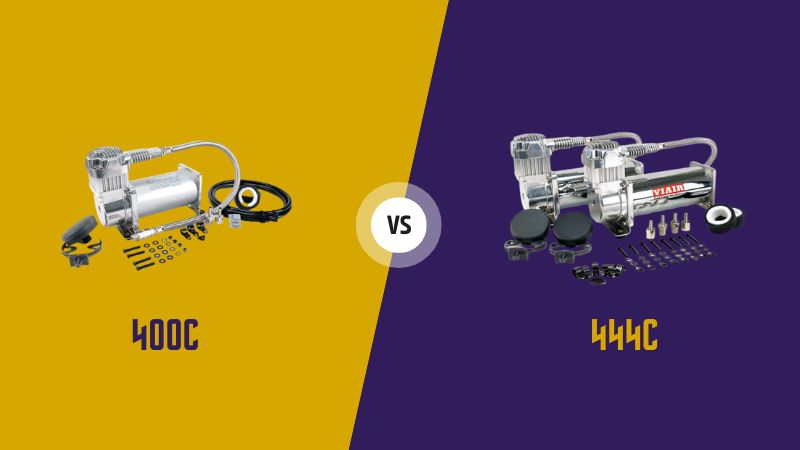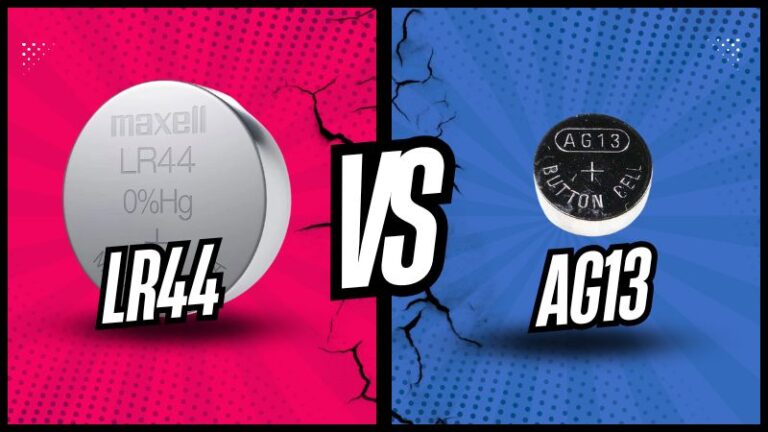Choosing the right air compressor for specific needs can be a daunting task, especially when faced with several high-quality options. VIAIR, a renowned name in the world of air compressors, presents us with two exceptional models, the 444C and the 400C. In this comparison, we’ll delve into the shared attributes and unique features of each, coupled with their respective pros and cons, to provide clarity for potential buyers.
Shared Strengths: Common Ground
Build Quality: VIAIR, over the years, has carved a niche for itself with its unyielding commitment to quality. Both the 444C and 400C exemplify this dedication, built using high-grade materials that promise a long service life. Every component, down to the tiniest screw, has been chosen with care, ensuring that the compressors not only withstand regular wear and tear but also endure more taxing conditions.
Safety Protocols: Safety is paramount when dealing with equipment that operates under pressure. VIAIR understands this, and both the 444C and 400C come equipped with a slew of safety measures. From automatic shut-off systems to pressure relief mechanisms, these compressors ensure that operations remain risk-free. Thermal overload protectors are another added feature, guarding against potential overheating and maintaining safe operational temperatures.
Energy Efficiency: In an era where sustainable practices are being embraced worldwide, VIAIR ensures its products are not left behind. The 444C and 400C are optimized for maximum performance while being energy efficient. This not only reduces operational costs but also ensures that the carbon footprint remains minimal. The motors in both models are designed to draw the least amount of current, thereby promoting longer duty cycles and reducing battery drain.
Consistent Performance: Nothing speaks to the quality of a tool better than its reliability. The 444C and 400C, with their advanced engineering, provide a consistent airflow irrespective of the operational demands. This level of reliability ensures that users can predict and depend on their performance, leading to smoother project executions.
Versatility: One of the hallmarks of VIAIR compressors is their versatility, and these two models are no exception. Be it inflating tires, actuating air horns, or running pneumatic systems, the 444C and 400C have been designed to manage a broad spectrum of tasks. Their adaptability negates the need for multiple devices, making them ideal for various roles. Furthermore, the inclusions of different attachments and accessories with both models further enhance their versatility, catering to specialized tasks as needed.
User-Friendly Operations: Despite their advanced features, both the 444C and 400C remain user-friendly. Clearly marked controls, easy setup procedures, and intuitive design ensure that even those unfamiliar with air compressors can use them without a steep learning curve. This emphasis on user experience underlines VIAIR’s commitment to making professional-grade tools accessible to a wider audience.
Moisture Resistance: Working in diverse environments means exposure to different levels of humidity. Both these compressors come with moisture-resistant features that ensure the internal components remain unaffected by ambient moisture levels. This feature not only extends the lifespan of the compressor but also ensures that the air output remains free from water contaminants.
Performance Metrics: The 444C is designed to be a powerhouse. Its advanced mechanisms and dual pack configuration allow for superior performance, especially when the need arises for simultaneous operations or filling multiple air springs. It’s optimized for heavy-duty applications, making it the go-to choice for professionals who require uninterrupted and robust performance. On the other hand, the 400C, though powerful in its own right, is better suited for standard applications, providing consistent performance without the frills.
Duty Cycle: A crucial factor for many professionals is the duty cycle of an air compressor, which indicates how long it can run continuously without overheating. Here, the 444C slightly edges out with its longer duty cycle. Designed for environments that demand prolonged operations, this model can sustain longer work periods, reducing downtime. The 400C, while still impressive, might need more frequent breaks during extended use, which could factor into the decision-making process for those requiring near-continuous operations.
Noise Levels: Operational noise can be a concern, especially in residential or noise-sensitive environments. Here, the 400C takes a slight lead. Its design emphasizes quiet operation, integrating sound insulation measures that reduce its operational noise. The 444C, given its robust performance, tends to be a bit louder, making the 400C a preferred choice for those prioritizing quieter operations.
Physical Dimensions: Size and portability can be deciding factors, especially for those with limited workspace or the need for mobility. The 400C champions this aspect with its more compact dimensions, allowing for easier transportation and storage. The 444C, offering more power and features, is inherently bulkier. For users who are constantly on the move or have spatial constraints, the size differential between the two might be a pivotal factor.
Price Factor: Budget often plays a significant role in decision-making. The 444C, with its advanced features, enhanced performance metrics, and superior duty cycle, is generally priced higher than the 400C. While the premium is justifiable given its offerings, the 400C provides an economical alternative without major compromises. It’s a balance of what features are essential versus what one is willing to invest.
Installation and Maintenance: Given the advanced nature of the 444C, its installation might be slightly more involved, requiring a bit more time and possibly professional assistance. On the other hand, the 400C, with its straightforward design, ensures an easier installation process. Maintenance-wise, the 444C, owing to its superior features, might demand more regular check-ups to ensure it operates at peak performance. The 400C offers a more straightforward maintenance routine, which could be a bonus for users not wanting to invest too much time in upkeep.
Accessories and Customization: The 444C, being a more premium model, often comes with a broader range of accessories and add-ons, allowing users to tailor their experience further. This customization can be a boon for specific applications or needs. The 400C, while still versatile, might offer fewer customization options right out of the box.
VIAIR 444C: Pros and Cons
Pros:
- Dual pack configuration for enhanced performance.
- Superior duty cycle suitable for extended operations.
- Durable and robust build.
Cons:
- Slightly bulkier, impacting portability.
- Comes at a higher price point compared to the 400C.
VIAIR 400C: Pros and Cons
Pros:
- Compact design making it space-efficient and portable.
- Quieter operations.
- Offers great value for its price.
Cons:
- Might not be as versatile as the 444C in high-demand scenarios.
- Slightly inferior duty cycle compared to the 444C.
In conclusion, both the VIAIR 444C and 400C are top-tier offerings in their category. The right choice boils down to individual needs, preferences, and budget. While the 444C may be apt for those seeking enhanced performance and longer duty cycles, the 400C shines in terms of portability and value for money. As always, understanding one’s requirements and aligning them with the product’s features ensures a satisfactory purchase.




